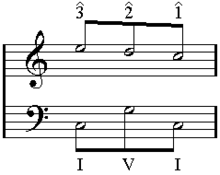

In Schenkerian analysis, the bass arpeggiation (German: Bassbrechung) is the bass pattern forming the deep background of tonal musical works. It consists in scale steps (de: Stufen) I-V-I, each of which may span hundreds of measures of music in the foreground.[2]
The bass pattern is an arpeggiation in the sense that its middle note (V) first arises as the fifth of the elaborated chord (I), of which it is the upper-fifth divider.[3] It is only when it meets with the passing note ![]() of the fundamental line that V becomes an independent chord within the first one.[4] See also Schenkerian analysis, The arpeggiation of the bass and the divider at the fifth.
of the fundamental line that V becomes an independent chord within the first one.[4] See also Schenkerian analysis, The arpeggiation of the bass and the divider at the fifth.
The bass arpeggiation properly speaking consists in the three scale steps I-V-I exclusively, but it may be elaborated at a remote level: see Schenkerian analysis, Elaboration of the bass arpeggiation.

